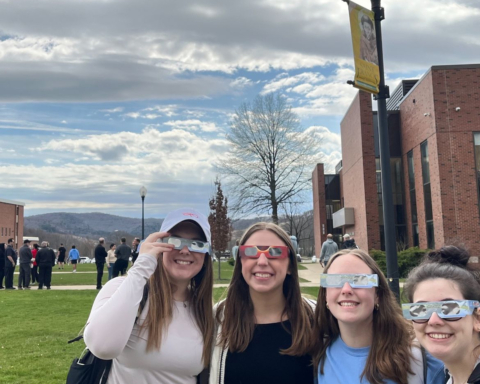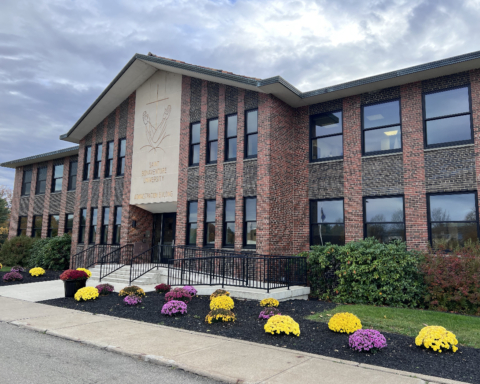
By Emma Zaremba
Features Assignment Editor
Albany Law Professor Paul Finkelman visited campus Wednesday lecturing about the issues of religious monuments on public property. He conveyed his belief that although we look to biblical texts for a moral approach to our lives, we shouldn’t for a political or civil approach.
Finkelman illustrated the different varieties of religious monuments (specifically Ten Commandments monuments that exist in our country) and gave examples of why they are controversial. The first and smallest variety are those that were put up a long time ago and are generally not about the actual Ten Commandments themselves, but what’s been put on them in an incidental way.
“In the Allegheny County courthouse in Pittsburgh, there is a small plaque that has the Ten Commandments on it and was put up after World War I as a memorial to soldiers from the county who had died in the war,” Finkelman said. “Now what the Ten Commandments has to do with World War I would be a good question, and why you would have a plaque that says ‘thou shall not kill’ on it is once again an interesting question.”
While it isn’t directly stated as one of the Ten Commandments on the plaque, it refers to them and can be seen as offensive to families of those who have fallen. According to Finkelman, the other type of monuments are the most problematic. The more recent monuments are usually put up for the purpose of asserting a religious statement on the part of the government official that’s putting it up.
The Chief Justice of Alabama, Roy Moore, put up an infamous monument in his own court room about 10 years ago, according to Finkelman. He set up a Ten Commandments plaque right in his court room, creating a recipe for social conflict.
“People thought this violated the traditional doctrines of church and state,” Finkelman said. “He refused to take them down and said, ‘I will quit my job as the judge because I will never take the Ten Commandments down.’”
Finkelman said the problems of displaying religious monuments in public space span further than those between the separation of church and state.
“The issues of translation, numbering, and order truly matter,” Finkelman said.
The Ten Commandments’ numbering differs throughout Judaism, Protestantism, Lutheranism and Catholicism. Therefore, it’s difficult to say which one is right, and further depicts why monuments of one religion’s Ten Commandments can be hung just anywhere, Finkelman said.
“If you take your faith seriously, then you should be concerned about putting up a religions monument,” Finkelman said. “We have a long history of the government being involved in religion, and what we know is when the government gets involved with religion, two things happen. Individuals suffer because they have to contend with the government, and in the end the church suffers.”
Nicholas Taylor, junior sociology major, said he found Finkelman’s speech interesting. He specifically enjoyed how Finkelman discussed the thought process of the judge who put the Ten Commandments statue in the Alabama Supreme Court Building, and why he thought it was wrong.
“The most interesting point I thought Professor Finkelman made was when he was talking about the Ten Commandments being the moral foundation for our country’s law,” Taylor said. “He said that was one of the reasons the judge put the statue in the court building — he thought it was the moral foundation for our country’s law.”
Finkelman then discredited this, saying that if the Commandments were the basis for our law, our country would be completely different.
“People in the United States lie, commit adultery and kill,” said Finkelman. “If committing adultery was illegal, we would have to go back and redefine adultery, and our whole country would be changed.”
After listening to the lecture, Taylor shared his opinion on the issue. He doesn’t think it’s right for America to be represented through one set of religious views.
“When it comes down to religious monuments being in courthouses or public places, I don’t think it should be allowed,” Taylor said. “The United States allows for people to practice the freedom of religion, and the Constitution prevents the U.S. from establishing one religion as the supreme religion of the land,. So to put a religious monument in a courthouse where the law is practiced and people of different religions have to go on a daily basis seems to defy the Constitution.”
Taylor looked back on the lecture as a worthwhile experience.
“I think Professor Finkelman is a great guy,” Taylor said. “He made a lot of interesting points in tonight’s discussion. He is a well-respected man in the legal world.”
Laurie Anne Wickens, a freshman marketing major, shares Taylor’s point of view.
“I thought his points were very interesting. I went in very single-minded and having some preconceptions about this subject,” Wickens said. “After hearing his presentation, however, I definitely am more open to considering a different viewpoint on the topic of the Ten Commandments in public places, as well as possibly even changing the view.”
Finkleman had several arguments to support his claims that made the issue a level of high importance among all those who attended.
“When you think of the basis of American law, it’s not the Ten Commandments, it’s the Declaration of Independence,” Finkelman said.





